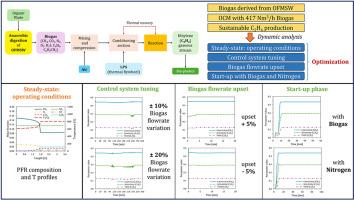Dynamic analysis of the oxidative coupling of methane (OCM) process to produce sustainable ethylene from biogas derived from organic fraction of municipal solid waste (OFMSW)
IF 5.8
2区 生物学
Q1 AGRICULTURAL ENGINEERING
引用次数: 0
Abstract
This study investigates the Oxidative Coupling of Methane (OCM) process, a technology designed to convert methane into ethylene, a valuable chemical. Specifically, a dynamic analysis is conducted to evaluate the performance of a plug-flow reactor in the OCM process for producing sustainable ethylene from biogas derived from the anaerobic digestion of OFMSW (Organic Fraction of Municipal Solid Waste). The dynamic behavior of the system is assessed using Aspen HYSYS simulation software to ensure both process productivity and safety. A steady-state analysis of the reactor is conducted, using a kinetic model based on a Na2WO4/Mn/SiO2 catalyst to operate with 417 Nm3/h of biogas. An inlet temperature of 610 °C to activate the reaction, and a pressure of 300 kPa to take advantage of low-pressure operation benefits. Based on trial and error method, the controllers are tuned and optimized to achieve the desired system response, with biogas flowrate variations (±10 % and ±20 %). Biogas flowrate upset (±5 %) tests are conducted to evaluate the system's response. Additionally, start-up tests are performed using biogas and nitrogen streams to determine an enhanced procedure for managing the process under dynamic conditions. The control system is fine-tuned, successfully limiting the reactor temperature to safe levels, below 800 °C. Flowrate variations are managed adjusting the key process parameters accordingly to maximize methane conversion, ethylene selectivity, and yield. Rapid start-up phases, allow to reach steady-state conditions approximately 13 min with biogas and 12 min with nitrogen.

城市生活垃圾有机组分沼气氧化偶联法制备乙烯的动态分析
本研究研究了甲烷氧化偶联(OCM)过程,这是一种将甲烷转化为乙烯(一种有价值的化学物质)的技术。具体来说,我们进行了动态分析,以评估塞流反应器在OCM工艺中从OFMSW(城市固体废物有机部分)厌氧消化产生的沼气中生产可持续乙烯的性能。利用Aspen HYSYS仿真软件对系统的动态行为进行评估,以确保生产效率和安全性。采用基于Na2WO4/Mn/SiO2催化剂的动力学模型,在417 Nm3/h的沼气条件下对反应器进行了稳态分析。入口温度为610°C,以激活反应,压力为300千帕,以利用低压操作的优势。基于试错法,控制器被调整和优化,以达到所需的系统响应,沼气流量变化(±10%和±20%)。进行了沼气流量波动(±5%)试验,以评估系统的响应。此外,使用沼气和氮气流进行启动测试,以确定在动态条件下管理过程的增强程序。控制系统经过微调,成功地将反应堆温度限制在800°C以下的安全水平。对流量变化进行管理,相应调整关键工艺参数,以最大限度地提高甲烷转化率、乙烯选择性和收率。快速启动阶段,允许达到稳态条件约13分钟沼气和12分钟氮气。
本文章由计算机程序翻译,如有差异,请以英文原文为准。
求助全文
约1分钟内获得全文
求助全文
来源期刊

Biomass & Bioenergy
工程技术-能源与燃料
CiteScore
11.50
自引率
3.30%
发文量
258
审稿时长
60 days
期刊介绍:
Biomass & Bioenergy is an international journal publishing original research papers and short communications, review articles and case studies on biological resources, chemical and biological processes, and biomass products for new renewable sources of energy and materials.
The scope of the journal extends to the environmental, management and economic aspects of biomass and bioenergy.
Key areas covered by the journal:
• Biomass: sources, energy crop production processes, genetic improvements, composition. Please note that research on these biomass subjects must be linked directly to bioenergy generation.
• Biological Residues: residues/rests from agricultural production, forestry and plantations (palm, sugar etc), processing industries, and municipal sources (MSW). Papers on the use of biomass residues through innovative processes/technological novelty and/or consideration of feedstock/system sustainability (or unsustainability) are welcomed. However waste treatment processes and pollution control or mitigation which are only tangentially related to bioenergy are not in the scope of the journal, as they are more suited to publications in the environmental arena. Papers that describe conventional waste streams (ie well described in existing literature) that do not empirically address ''new'' added value from the process are not suitable for submission to the journal.
• Bioenergy Processes: fermentations, thermochemical conversions, liquid and gaseous fuels, and petrochemical substitutes
• Bioenergy Utilization: direct combustion, gasification, electricity production, chemical processes, and by-product remediation
• Biomass and the Environment: carbon cycle, the net energy efficiency of bioenergy systems, assessment of sustainability, and biodiversity issues.
 求助内容:
求助内容: 应助结果提醒方式:
应助结果提醒方式:


